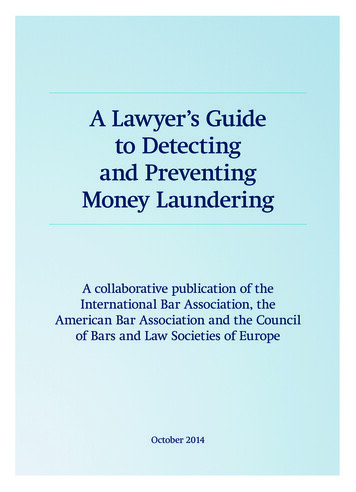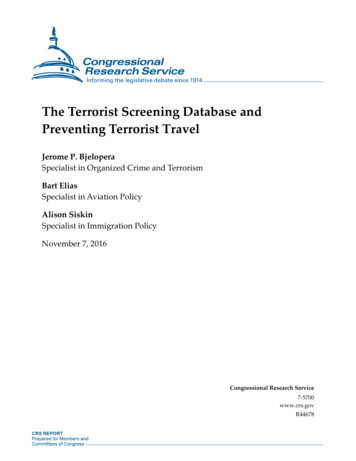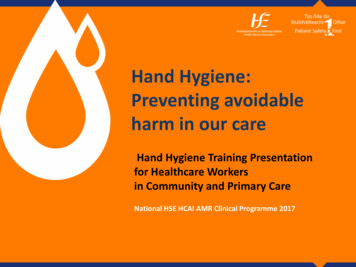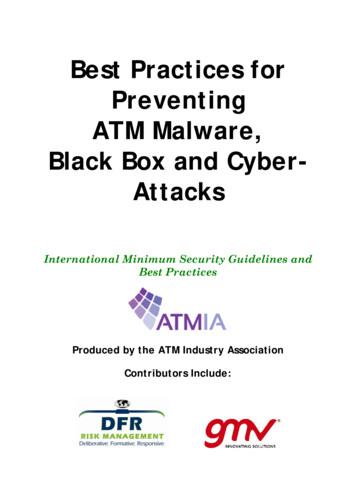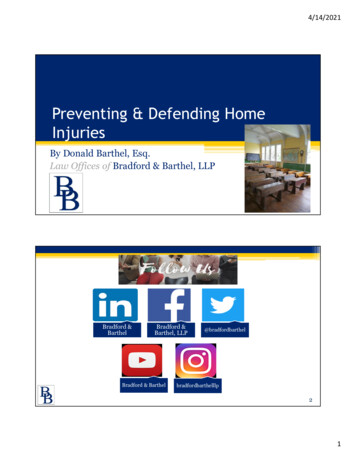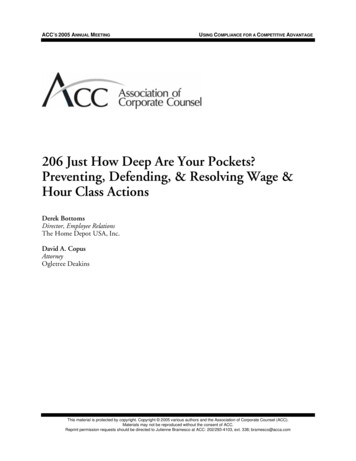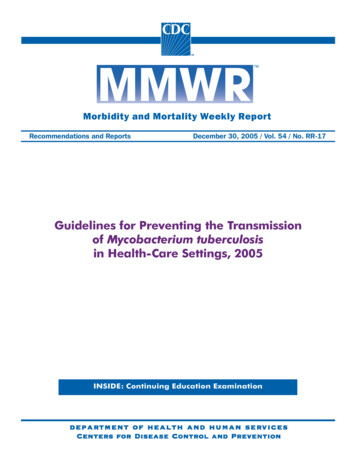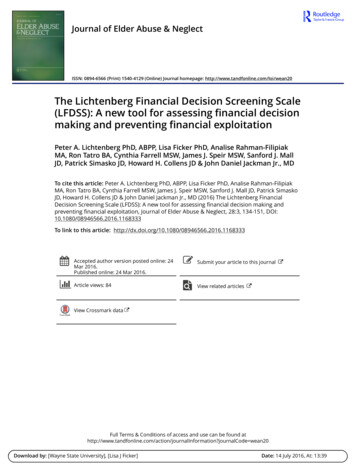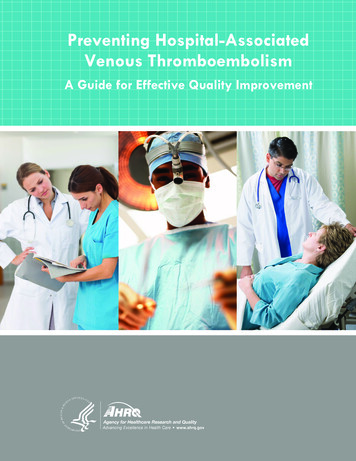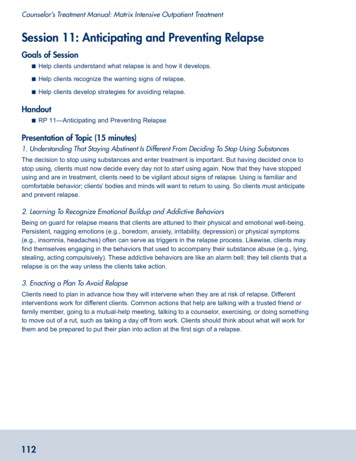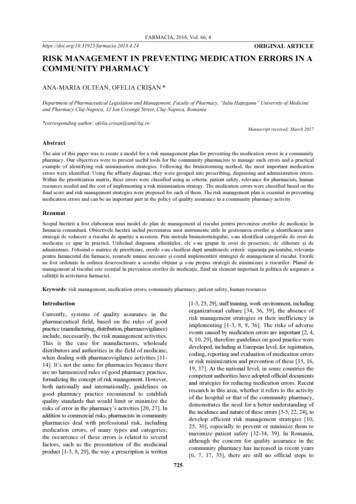
Transcription
FARMACIA, 2018, Vol. 66, AL ARTICLERISK MANAGEMENT IN PREVENTING MEDICATION ERRORS IN ACOMMUNITY PHARMACYANA-MARIA OLTEAN, OFELIA CRIŞAN *Department of Pharmaceutical Legislation and Management, Faculty of Pharmacy, “Iuliu Haţieganu” University of Medicineand Pharmacy Cluj-Napoca, 12 Ion Creangă Street, Cluj-Napoca, Romania*corresponding author: ofelia.crisan@umfcluj.roManuscript received: March 2017AbstractThe aim of this paper was to create a model for a risk management plan for preventing the medication errors in a communitypharmacy. Our objectives were to present useful tools for the community pharmacists to manage such errors and a practicalexample of identifying risk minimisation strategies. Following the brainstorming method, the most important medicationerrors were identified. Using the affinity diagram, they were grouped into prescribing, dispensing and administration errors.Within the prioritization matrix, these errors were classified using as criteria: patient safety, relevance for pharmacists, humanresources needed and the cost of implementing a risk minimisation strategy. The medication errors were classified based on thefinal score and risk management strategies were proposed for each of them. The risk management plan is essential in preventingmedication errors and can be an important part in the policy of quality assurance in a community pharmacy activity.RezumatScopul lucrării a fost elaborarea unui model de plan de management al riscului pentru prevenirea erorilor de medicaţie înfarmacia comunitară. Obiectivele lucrării includ prezentarea unor instrumente utile în gestionarea erorilor şi identificarea unorstrategii de reducere a riscului de apariţie a acestora. Prin metoda brainstormingului, s-au identificat categoriile de erori demedicaţie ce apar în practică. Utilizând diagrama afinităţilor, ele s-au grupat în erori de prescriere, de eliberare şi deadministrare. Folosind o matrice de prioritizare, erorile s-au clasificat după următoarele criterii: siguranţa pacientului, relevanţapentru farmacistul din farmacie, resursele umane necesare şi costul implementării strategiei de management al riscului. Erorileau fost ordonate în ordinea descrescătoare a scorului obţinut şi s-au propus strategii de minimizare a riscurilor. Planul demanagement al riscului este esenţial în prevenirea erorilor de medicaţie, fiind un element important în politica de asigurare acalităţii în activitatea farmaciei.Keywords: risk management, medication errors, community pharmacy, patient safety, human resourcesIntroduction[1-3, 25, 29], staff training, work environment, includingorganizational culture [34, 36, 39], the absence ofrisk management strategies or their inefficiency inimplementing [1-3, 8, 9, 36]. The risks of adverseevents caused by medication errors are important [2, 4,8, 10, 29], therefore guidelines on good practice weredeveloped, including at European level, for registration,coding, reporting and evaluation of medication errorsor risk minimization and prevention of these [15, 16,19, 37]. At the national level, in some countries thecompetent authorities have adopted official documentsand strategies for reducing medication errors. Recentresearch in this area, whether it refers to the activityof the hospital or that of the community pharmacy,demonstrates the need for a better understanding ofthe incidence and nature of these errors [3-5, 22, 24], todevelop efficient risk management strategies [10,25, 30], especially to prevent or minimize them tomaximize patient safety [32-34, 39]. In Romania,although the concern for quality assurance in thecommunity pharmacy has increased in recent years[6, 7, 17, 35], there are still no official steps toCurrently, systems of quality assurance in thepharmaceutical field, based on the rules of goodpractice (manufacturing, distribution, pharmacovigilance)include, necessarily, the risk management activities.This is the case for manufacturers, wholesaledistributors and authorities in the field of medicine,when dealing with pharmacovigilance activities [1114]. It’s not the same for pharmacies because thereare no harmonized rules of good pharmacy practice,formalizing the concept of risk management. However,both nationally and internationally, guidelines ongood pharmacy practice recommend to establishquality standards that would limit or minimize therisks of error in the pharmacy’s activities [20, 27]. Inaddition to commercial risks, pharmacists in communitypharmacies deal with professional risk, includingmedication errors, of many types and categories;the occurrence of these errors is related to severalfactors, such as the presentation of the medicinalproduct [1-3, 8, 29], the way a prescription is written725
FARMACIA, 2018, Vol. 66, 4implement risk management strategies at this level.The purpose of this paper was to develop an exampleof a risk management plan for the most importantmedication errors encountered in a communitypharmacy. The work objectives included presentinguseful tools in the management of these errors bypharmacists and a practical example of identifyingstrategies to minimize the risk of medication errors.The score assigned to each medication errors for eachcriterion was between 1 and 5, as follows: “Patientsafety” criterion: 1 is assigned to medication errorswhich do not endanger the safety of the patient, and5 is assigned to medication errors that jeopardizepatient safety; “Relevance to the community pharmacist”criterion: 1 is assigned to medication errors for whichthe community pharmacist cannot implement a strategyof risk management, and 5 is assigned to medicationerrors for which the pharmacist can play an importantrole in establishing risk management strategies;“Human resources required for risk mitigation”criterion: 1 is assigned to medication errors whichmanagement requires additional human resourcesand 5 is assigned to medication errors that can bemanaged without additional human resources; “Thecost of implementing a risk management strategy”criterion: 1 is assigned to medication errors for whichimplementing a risk management strategy involvesadditional financial resources, and 5 is assigned tomedication errors for which implementing a riskmanagement strategy does not imply additionalfinancial resources.Considering that this plan is meant for implementingeffective risk management strategies in a communitypharmacy, we decided to assign to the “relevance tothe community pharmacist” criterion a weight of 3 andto the “human resources required for risk mitigation”criterion a weight of 2. For the other two criteria,we have decided to assign a weight of 1.After establishing the criteria, rating scale and weight,the prioritization matrix was created. In a squarematrix, the first column lists all errors identified, bycategory, and the first row lists the prioritizationcriteria established. The next step in completing thematrix was to assign to each error, for each criterion,a score from 1 to 5, then to multiply each of thosescores with the weight established for each criterion,followed by summing up these partial scores to obtaina total score per error. Thus, the applied prioritizationmatrix regarding medication errors are depicted inTable I.Based on the scores obtained, medication errors wereordered from high to low. After that, risk minimizationstrategies were set out for each error. Depending onavailable resources, these strategies were implementedbased on the order established in the prioritizationmatrix. This paper suggests examples of strategies toprevent medication errors in a community pharmacy.Table IA model for the prioritization matrixMaterials and MethodsTo identify medication errors that may occur in acommunity pharmacy, the brainstorming method wasused, as a useful creative method for the qualitymanagement [18]. The method was applied togetherwith health professionals, pharmacists with experiencein different fields (pharmaceutical industry, communitypharmacy, hospital pharmacy) and a specialisedphysician. Because the brainstorming does not alwaysprovide the most objective assessment of the identifiedproblems, we used this method combined with othertools, which are designed to classify the items identified[18]. To group medication errors identified, based ontheir relationships, the affinity diagram was used [21,38]. Because of the large number of possible errors(identified) and limited resources that a pharmacycan have at a time, it may be necessary to prioritizeresources allocation. In this respect, we exemplified theuse of a prioritization matrix. In creating a prioritizationmatrix, an important aspect is setting the criteria to beconsidered for prioritization and that are importantto everyone involved, respectively the establishingof the rating scale. Each rating is a numerical valuethat indicates the extent to which that criterion isimportant in setting priorities, including in relation toother criteria, i.e. its share in the overall evaluation.For each criterion, a specific score is calculated usingboth its rating and the importance or the weight ofthat specific criterion for each evaluated medicationerror [23, 28, 31]. Given our intention to develop a riskmanagement plan, we have established four criteriathat we consider in the process of prioritizingmedication errors. These criteria are: patient safety;relevance to the community pharmacist, which refersto the ability/right of the pharmacist to make a changeat the time of dispensing the medication; humanresources required for risk mitigation; the cost ofimplementing a risk management strategy.Patient safety Relevance for Human resources(A x 1)the community required for riskpharmacistmitigation(B x 3)(C x 2)Medication error 1A1 x 1B1 x 3C1 x 2Medication error 2A2 x 1B2 x 3C2 x 2Medication error 3A3 x 1B3 x 3C3 x 2726The cost ofimplementing a riskmanagement strategy(D x 1)D1 x 1D2 x 1D3 x 1Final scoreA1 3B1 2C1 D1A2 3B2 2C2 D2A3 3B3 2C3 D3
FARMACIA, 2018, Vol. 66, 4Results and Discussiona wrong medicinal product with resembling outerpackaging; dispensing a wrong medicinal productwith resembling commercial name; prescribing amedicinal product from a wrong therapeutic class;administering a wrong dose of medicinal product to achild or new-born, based on a miscalculation relatedto the weight in kg; wrong dilution when preparing asolution; prescribing a dose/kg body weight to a child,but omitting the final dose calculation/administration;wrong dispensing/administering due to misinterpretationof milligrams (mg) as micrograms (mcg); not changingthe dose when changing the administration route;wrong splitting of a medicinal product; wrongreplacement of a medicinal product.“Illegible writing” was considered a medication errorcategory, because it is possible that the pharmacistmay not correctly understand the prescribing physicianhandwriting and accidentally release another drugwith a resembling name. “Wrong formulation” wasconsidered an error category that may occur in thepreparation of medicinal products in pharmacy.“Prescribing the wrong dose of medicinal product”error category may include cases more specific, suchas “Prescribing a too high dose” and “Prescribing atoo low dose”, for which just one category was kepti.e. “Prescribing the wrong dose of medicinal product”.After applying the brainstorming method, 35 categoriesof medication errors have been initially identified,as following: wrong prescribing of medicinal productconsidering the indications; wrong prescribing ofmedicinal product considering the contraindications;wrong prescribing of medicinal product considering thepatient's known allergies; prescribing a wrong dose ofmedicinal product; dispensing a wrong pharmaceuticalform; prescribing a wrong amount of medicinal product;dispensing a wrong amount of medicinal product;wrong choice of administration route; dispensing awrong concentration of medicinal product; wrongfrequency in administering the medicinal product;wrong dosage regimen; illegible writing; prescribinga too high dose of a medicinal product; prescribing atoo low dose of a medicinal product; wrong formulation;improper storage of a medicinal product; wrongtechnique of administration; dispensing an expiredmedicinal product; dispensing a medicinal productwith damaged packaging; failure to monitor an importantparameter; administering a wrong concentration ofmedicinal product to a child or new-born; wronginformation about the patient in the medical record orprescription; administering a wrong dose of medicinalproduct; omission of medicinal products from asenior citizen medication; wrong counselling; dispensingTable IIClassification of the identified medication errors using the affinity diagramPrescribing errorsDispensing errorsAdministering errorsWrong prescribing of medicinal product Dispensing a wrong pharmaceutical Administering a wrong dose of medicinalconsidering the indicationsformproductWrong prescribing of medicinal productDispensing a wrong amount ofWrong choice of administration routeconsidering the contraindicationsmedicinal productWrong prescribing of medicinal product Dispensing a wrong concentration ofWrong frequency in administering theconsidering the patient's known allergiesmedicinal productmedicinal productPrescribing a wrong dose of medicinalWrong dosage regimenWrong technique of administrationproductPrescribing a wrong amount of medicinalDispensing an expired medicinalAdministering a wrong dose of medicinalproductproductproduct to a child or new-born, based on amiscalculation related to the weight in kgIllegible writingDispensing a medicinal product with Administering a wrong concentration ofdamaged packagingmedicinal product to a child or new-bornFailure to monitor an important parameterWrong counsellingWrong information about the patient in Dispensing a wrong medicinal productthe medical record or prescriptionwith resembling outer packagingOmission of medicinal pr
RISK MANAGEMENT IN PREVENTING MEDICATION ERRORS IN A COMMUNITY PHARMACY ANA-MARIA OLTEAN, OFELIA CRIŞAN * Department of Pharmaceutical Legislation and Management, Faculty of Pharmacy, “Iuliu Haţieganu” University of Medicine and Pharmacy Cluj-Napoca, 12 Ion Creangă Street, Cluj-Napoca, Romania *corresponding author: ofelia.crisan@umfcluj.ro

